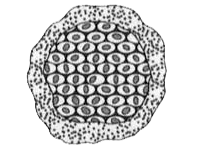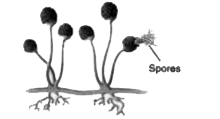Complete Solutions to TOPIC - 1 (BASICS OF REPRODUCTION, ASEXUAL REPRODUCTION AND VEGETATIVE PROPAGATION)(SHORT ANSWER TYPE QUESTIONS - II) of chapter HOW DO ORGANISMS REPRODUCE? of Class 10 book with complete answers and questions
| Class 10 | BIOLOGY |
| Chapter | HOW DO ORGANISMS REPRODUCE? |
| OSWAAL PUBLICATION | TOPIC - 1 (BASICS OF REPRODUCTION, ASEXUAL REPRODUCTION AND VEGETATIVE PROPAGATION)(SHORT ANSWER TYPE QUESTIONS - II) |
| Number Of Questions | 22 |
| Academic Year | 2023-24 |
What is vegetative propagation? When is it used? List two uses.
View SolutionIn the context of reproduction of species state the main difference between fission and fragmentation. Also give one example of each.
View SolutionExplain the term "Regeneration" as used in relation to reproduction of organisms. Describe briefly how regeneration is carried out in multicellular organisms like Hydra.
View SolutionThe process of spore formation takes place in many simple multicellular organisms which have certain reproductive parts that can be identified.
(i) Name the organism using this process.
(ii) Name the reproductive and non-reproductive parts of such organisms.
View Solution(i) With the help of a diagram demonstrate the process of regeneration as seen in Planaria.
(ii) Which type of cells are used by such multi-cellular organisms to regenerate?
View SolutionThe picture given below depicts the process of asexual reproduction in Plasmodium.

(i) Name the process depicted above and define it.
(ii) What is meant by asexual reproduction?
View SolutionWhy is DNA copying an essential part of the process of reproduction? What are the advantages of sexual reproduction over asexual reproduction?
View SolutionWhy is DNA copying an essential part of the process of reproduction?
View SolutionExplain the process of regeneration in Planaria. How is this process different from reproduction?
View SolutionWrite one main difference between asexual and sexual mode of reproduction. Which species is likely to have comparatively better chances of survival-the one reproducing asexually or the one reproducing sexually? Justify your answer.
View SolutionList any two modes of asexual reproduction in animals. Under which mode of reproduction is vegetative propagation placed and why? List two advantages of vegetative propagation.
View SolutionDefine the following processes of asexual reproduction :
(i) Spore formation, (ii) Regeneration, (iii) Multiple fission.
View Solution(a) Name any two plants that reproduce by grafting.
(b) List any two benefits to an organism that reproduces through spores?
View Solution(i) With the help of a diagram, show asexual reproduction in Rhizopus?
(ii) How this method is advantageous for Rhizopus?
View Solution(i) Differentiate between binary and multiple fission. Name an organism that reproduces by multiple fission.
(ii) Vegetative propagation is beneficial to plants that are propagated asexually. Give two advantages.
View SolutionWhat is the effect of DNA copying, which is not perfectly accurate, on the reproduction process? How does the amount of DNA remain constant though each new generation is a combination of DNA copies of two individuals?
View Solution(a) Name the following :
(i) Thread like non-reproductive structures present in Rhizopus.
(ii) 'Blobs' that develop at the tips of the non- reproductive threads in Rhizopus.
(b) Explain how these structures protect themselves and what is the function of the structures released from the 'blobs' in Rhizopus.
View SolutionMention three differences between asexual and sexual reproduction.
View SolutionHow do organisms, whether reproduced asexually or sexually maintain a constant chromosome number through several generations? Explain with the help of suitable example.
View SolutionWhat is multiple fission? How does it occur in an organism? Explain briefly. Name one organism which exhibits this type of reproduction.
View Solution(i) Identify the process depicted in the diagram given below.

(ii) The part labelled as spores has a covering of thick walls around it. What is its advantage?
(iii) What are hyphae?
View SolutionWhat happens when
(i) Planaria gets cut into two pieces
(ii) A mature Spirogyra filament attains considerable length?
(iii) On maturation sporangia burst?
View Solution
TOPIC - 1 (BASICS OF REPRODUCTION, ASEXUAL REPRODUCTION AND VEGETATIVE PROPAGATION)(SHORT ANSWER TYPE QUESTIONS - II) questions and complete solutions for chapter HOW DO ORGANISMS REPRODUCE? of OSWAAL BIOLOGY (KANNADA ENGLISH) of Class 10
All Exercises from OSWAAL PUBLICATION Class 10 BIOLOGY HOW DO ORGANISMS REPRODUCE?
- NCERT CORNER (TEXTBOOK EXERCISES)
- NCERT CORNER (INTEXT QUESTIONS)
- TOPIC - 1 (BASICS OF REPRODUCTION, ASEXUAL REPRODUCTION AND VEGETATIVE PROPAGATION)(LONG ANSWER TYPE QUESTIONS)
- TOPIC - 1 (BASICS OF REPRODUCTION, ASEXUAL REPRODUCTION AND VEGETATIVE PROPAGATION)(MATCH THE COLUMN)
- TOPIC - 1 (BASICS OF REPRODUCTION, ASEXUAL REPRODUCTION AND VEGETATIVE PROPAGATION)(MULTIPLE CHOICE QUESTIONS)
- TOPIC - 1 (BASICS OF REPRODUCTION, ASEXUAL REPRODUCTION AND VEGETATIVE PROPAGATION)(SHORT ANSWER TYPE QUESTIONS - I)
- TOPIC - 1 (BASICS OF REPRODUCTION, ASEXUAL REPRODUCTION AND VEGETATIVE PROPAGATION)(SHORT ANSWER TYPE QUESTIONS - II)
- TOPIC - 1 (BASICS OF REPRODUCTION, ASEXUAL REPRODUCTION AND VEGETATIVE PROPAGATION)(VERY SHORT ANSWER TYPE QUESTIONS)
- TOPIC - 2 (SEXUAL REPRODUCTION IN PLANTS)(LONG ANSWER TYPE QUESTIONS)
- TOPIC - 2 (SEXUAL REPRODUCTION IN PLANTS)(MATCH THE COLUMN)
- TOPIC - 2 (SEXUAL REPRODUCTION IN PLANTS)(MULTIPLE CHOICE QUESTIONS)
- TOPIC - 2 (SEXUAL REPRODUCTION IN PLANTS)(SHORT ANSWER TYPE QUESTIONS - I)
- TOPIC - 2 (SEXUAL REPRODUCTION IN PLANTS)(SHORT ANSWER TYPE QUESTIONS - II)
- TOPIC - 2 (SEXUAL REPRODUCTION IN PLANTS)(VERY SHORT ANSWER TYPE QUESTIONS)
- TOPIC - 3 (REPRODUCTION IN HUMAN BEINGS)(LONG ANSWER TYPE QUESTIONS)
- TOPIC - 3 (REPRODUCTION IN HUMAN BEINGS)(MATCH THE COLUMN)
- TOPIC - 3 (REPRODUCTION IN HUMAN BEINGS)(MULTIPLE CHOICE QUESTIONS)
- TOPIC - 3 (REPRODUCTION IN HUMAN BEINGS)(SHORT ANSWER TYPE QUESTIONS - I)
- TOPIC - 3 (REPRODUCTION IN HUMAN BEINGS)(SHORT ANSWER TYPE QUESTIONS - II)
- TOPIC - 3 (REPRODUCTION IN HUMAN BEINGS)(VERY SHORT ANSWER TYPE QUESTIONS)